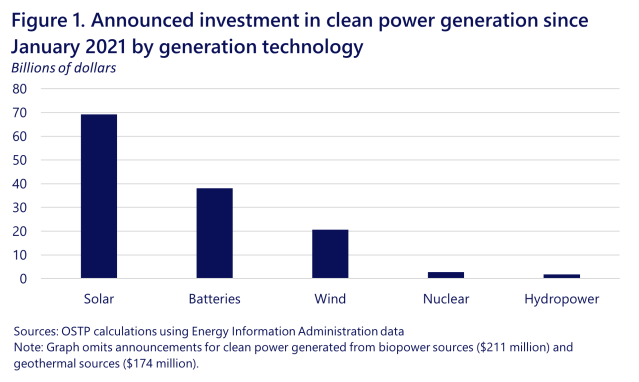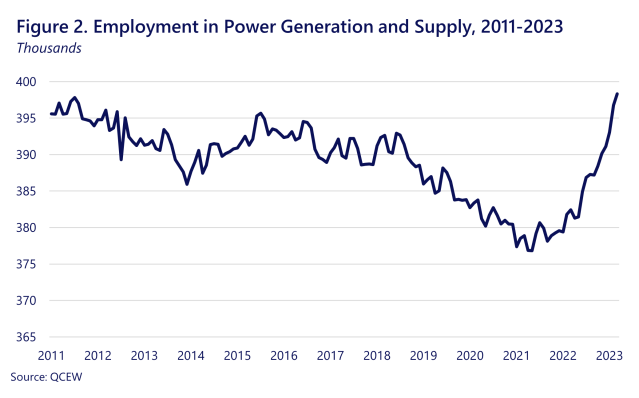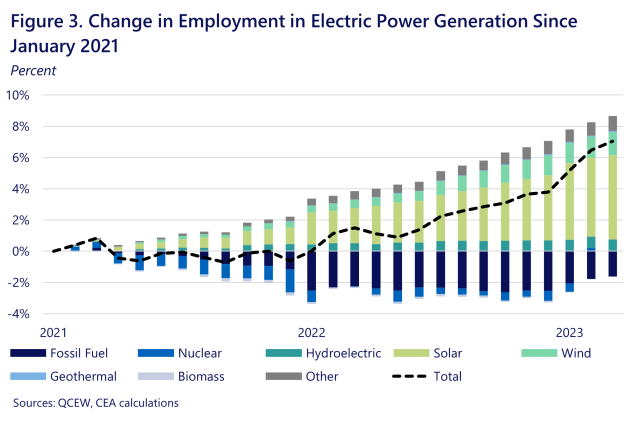Heather Boushey, Chief Economist, Investing in America Cabinet
New analyses of data from the Department of Energy, the Quarterly Census of Employment and Wages (QCEW), and the U.S. Energy Information Administration show clean energy job growth and record investments in the clean power sector since President Biden took office and enacted his Investing in America agenda—a key pillar of Bidenomics, the President’s economic plan to grow the economy from the middle out and bottom-up.
Strong investment in clean power generation and supply is critical to meeting President Biden’s goals of building the clean energy economy with high-quality job opportunities for American workers and addressing the climate crisis. Since the start of the Biden-Harris Administration, private companies have announced plans for about 94 GW of new clean power generation projects, representing an estimated $133 billion in investment as of August 2023 (Figure 1).[1] These announced investments in specific generation projects are a subset of a larger boom across American clean energy supply chains, including more than $70 billion of new investments in clean energy manufacturing and infrastructure.

These investments have spurred strong job growth. Between January 2021 and March 2023, the economy added 21,000 jobs in power generation and supply, reaching its highest level in more than a decade following a prolonged decline in employment in the industry (Figure 2).[2] Notably, more than half of these job gains occurred between August 2022 (when the Inflation Reduction Act and the CHIPS and Science Act—critical pieces of the President’s Investing in America agenda—were signed into law) and March 2023.
These job gains were driven by increased employment in electricity transmission and distribution and increased clean electric power generation. Between January 2021 and March 2023, the economy added 11,000 jobs in electric power transmission and distribution, 8,000 jobs in solar power generation, 2,000 jobs in wind power, and 1,000 jobs in hydroelectric power. Figure 3 depicts the percent change in employment in power generation, disaggregated by generation technology.


While the QCEW provides relatively timely data on job gains in specific energy industries, other data sources are necessary for a full picture of all energy-related jobs, including those in manufacturing and construction industries. The Department of Energy’s latest U.S. Energy and Employment Report (USEER), which uses data from 2022, includes a more complete definition of energy jobs,[3] and provides geographic and demographic breakdowns of energy employment. (USEER data from 2023 will be released in mid-2024.)
There are three main takeaways from the latest USEER report. First, when looking beyond power generation at the full range of clean energy jobs, the Department of Energy found that clean energy job growth outpaced job growth in the energy sector overall. Nationwide in 2022, clean energy jobs grew by 114,000 (3.9 percent) to 3.1 million jobs, compared to 300,000 jobs added (3.8 percent growth) in total energy-sector jobs. Clean energy jobs accounted for 40 percent of overall energy jobs.[4] Within certain energy technologies, clean energy jobs saw particularly strong gains. For example, transmission, distribution, and storage jobs associated with clean energy increased by 4.0 percent, outpacing the 2.2 percent growth seen in transmission, distribution, and storage jobs as a whole.
Notably, clean energy employment increased in all 50 States and the District of Columbia in 2022 (Figure 4).[5] Some states saw particularly large gains, with West Virginia, Oklahoma, and New Mexico leading clean energy job growth. Including traditional transmission and distribution, clean energy jobs in West Virginia increased 19.3 percent, while clean energy jobs increased by 9.1 percent in both New Mexico and Oklahoma.

Second, while women have long been underrepresented in the energy sector, 2022 saw progress as women accounted for over half of net energy jobs added, experiencing a 7.8 percent gain in employment over the year. As a result, the share of workers in the energy workforce who are women ticked up from 25 percent to 26 percent. In electric power generation, women’s employment grew by 65 percent; the Department of Energy attributed this to several likely factors, including an economy-wide increase in labor force participation for women and growth in industries such as professional and business services that are more likely to hire women.
Finally, the USEER data shows that energy sector employers are seeing the benefits of strong unions. Energy employers with unionized workforces reported substantially less difficulty hiring workers than non-unionized employers. According to the report, this may be in part because they invest in registered apprenticeship programs, which ensure a continuous pipeline of skilled and trained workers. Additionally, unionized workforces were more likely to have policies about recruiting from communities of color or women. Energy workers continue to be more likely to be covered by a union contract when compared to the private sector workforce as a whole. In 2022, 11 percent of workers in the energy sector were represented by a union or covered by a project labor or collective bargaining agreement, compared to 7 percent in the private sector overall.
The President understands that to grow the economy from the middle out and the bottom up, it is essential to invest in America—the first pillar of Bidenomics—by supporting critical industries like clean power generation. That is why the President has signed into law the Bipartisan Infrastructure Law and the Inflation Reduction Act, unlocking historic investments in infrastructure, clean energy, domestic supply chains, and more. In order to implement this legislation successfully, and to ensure the economic growth is equitably distributed, it is also necessary to create good jobs and empower workers—the second pillar of Bidenomics.
The latest data on private sector investment and employment in power generation speak to the President’s success with both pillars—investing in America and empowering workers. Moving forward, the President’s investments are likely to support additional innovation and job growth in the energy sector.
The Administration’s ongoing push to create high-quality jobs, such as through incentives for fair wages, support for unionization, and training and recruitment pipelines, will help ensure that the benefits of this growing sector are shared equitably. Continuing to track the growth of the energy sector in this and other data will be an important part of ensuring that this Investing in America legislation is implemented in a way that benefits American workers, families, and communities.
[1] Jobs in the construction industry are not included in these estimates.
[2] This estimate reflects specific projects included in planning reports submitted to the U.S. Energy Information Administration that were not in meaningful planning or permitting stages prior to the start of the Administration. It does not capture all the new clean energy investments that companies have announced since the start of the Administration or all the projects that will benefit from the Inflation Reduction Act.
[3] For national-level data, clean energy jobs are defined as jobs with work related to the U.S.’s net zero goal (e.g., jobs related to renewable energy; grid technologies and storage; traditional electricity transmission and distribution for electricity; nuclear energy; a subset of energy efficiency that does not involve fossil fuel burning equipment; biofuels; and plug-in hybrid, battery electric, and hydrogen fuel cell vehicles and components).
[4] “Clean” jobs are defined as jobs in which more than 50 percent of time is devoted to clean energy technology areas.
[5] Clean energy jobs refer to a wider set of jobs in state-level data compared to the national definition noted in footnote 3. Notably, while both energy efficiency and traditional transmission and distribution are only partially included at the national level, both are incorporated into the state-level data.




